May: Still Following Elephants
The year 2023 had a lunar ‘leap’ month, urū-zuki, 閏月, intercalary-month, also read jun-getsu. There was a ‘leap’ 2nd month of 29 days, so that the lunar 3rd month began on April 20. The lunar 4th month began on May 20. Rikyū’s death on lunar 2nd month 29th day was in 1591, which had a ‘leap’ 2nd month, so that his actual day of death day coincided with April 21. The lunar 4th month is identified with the east southeast direction, and the Zodiac sign of Mi, 巳, Snake.
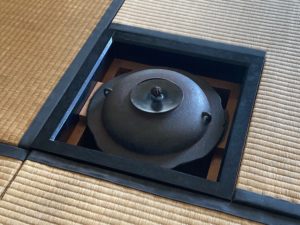
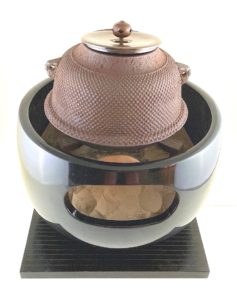
Left: the ro with the sukigi-gama resting on wooden blocks, (right): the furo with a kama supported on a gotoku.
The ro with the sukigi-gama is used in the 4th month, the furo is used in the 5th month. Because of the added lunar month, there may be some question as to when the first furo of the year should be introduced – which 5th month? The lunar or the solar?
According to the lunar calendar associated with the yojōhan Tearoom, the 4th and 5th lunar months are identified with the south wall of the room. The southeast direction which includes the Zodiac sign of Tatsu, 辰, Dragon, is known as Tatsu-Mi, 巽, Dragon-Snake, The Kanji for Tatsu-Mi, 巽, is also read Son, which is one of the ha-kke, 八卦, eight-signs, trigrams of the Eki-kyo, 易経, Change-sutra. The Kanji, Son, is identified with principle of Wind.
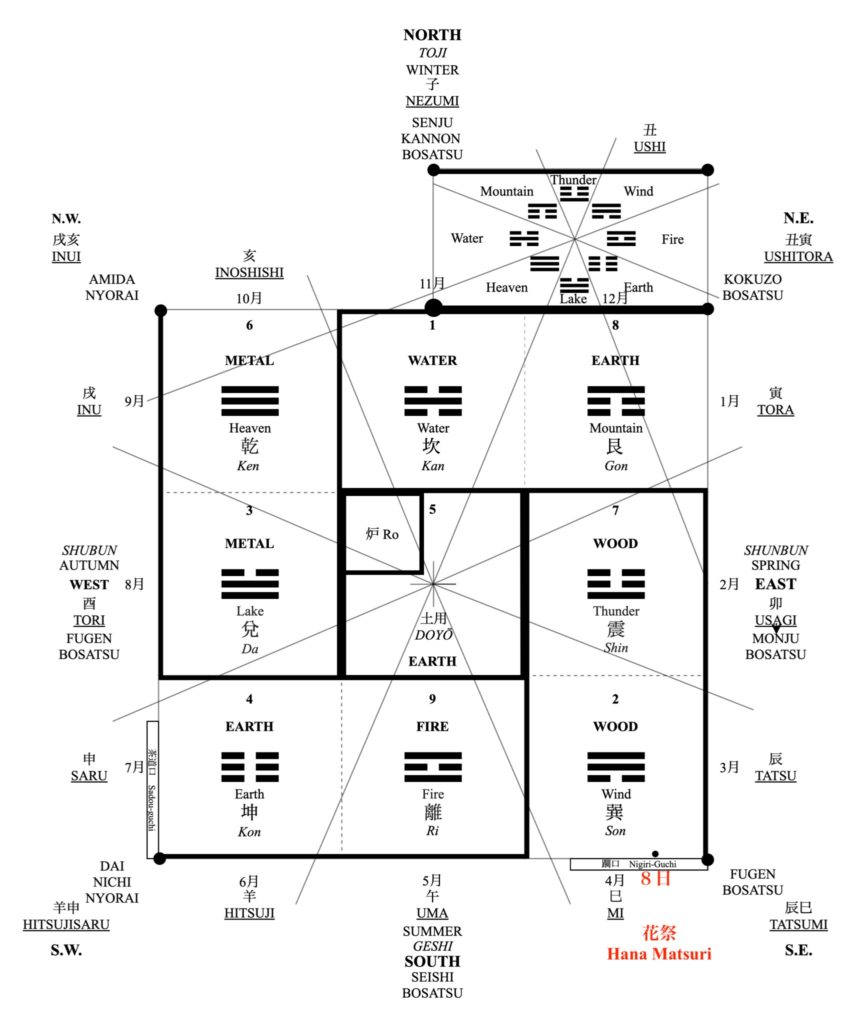
The Cha-shitsu, 茶室, Tea-room, like the world, is governed by the trigrams of the Ekikyō. The southeast corner of the Rikyū’s ideal yo-jō-han, 四畳半, four-mat-half, chashitsu is the location of the small entrance nijiri–guchi, 躙口, crawl in-opening. One of the most important Buddhist events is the birth of the Buddha, which occurred on the 8th day of the 4th moon, is called Kan-butsu-e, 灌仏会, Libate-buddha-meeting. It is more familiarly called Hana Matsuri, 花祭, Flower Festival.
In the lunar calendar, the moon on the 8th is a han-getsu, 半月, half-moon. The 8th day of each lunar month is the En-nichi, 縁日, Fete-day, of Yaku-shi Nyo-rai, 薬師如来, Medicine-master Like-become.
Both Zodiac signs of Dragon and Snake are protected by the Buddhist guardian Fu-gen Bo-satsu, 普賢菩薩, Universal-wisdom Grass-buddha. Fugen is often depicted with Mon-ju Bo-satsu, 文殊菩薩, Literary-exceptional Grass-buddha. Fugen and Monju are often depicted accompanying the historical Buddha in a grouping called Shaka Sanzon, 釈迦三尊, Explain-(sound) Three-lords: Shaka is Japanese for the Buddha’s family name of Sakya.
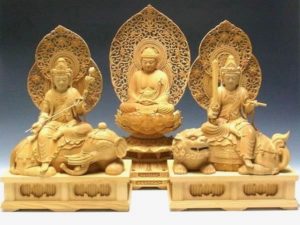
In the tokonoma of a Chashitsu, were an image of the Shaka Sanzon, 釈迦三尊, in which the Buddha was accompanied by Fugen on left and Monju on the right, the location of Fugen is on the side of the teishu, and Monju is on the side of the guests. Fugen is ‘practice’, the role of the teishu, and Monju is ‘learning’, which is the role of the guest. The tei-shu, 主, master of fire, as the character notes, is the one who builds, and is in charge of, the charcoal fire. The guest, at times, is offered smoking utensils, so that the guest handles and is in charge of the tobacco fire in the pipe.
Monju, identified with the east and the second lunar month, assists the guests in the east. Fugen in the southeast is identified with the fourth lunar month, which adjoins the realm of Monju.
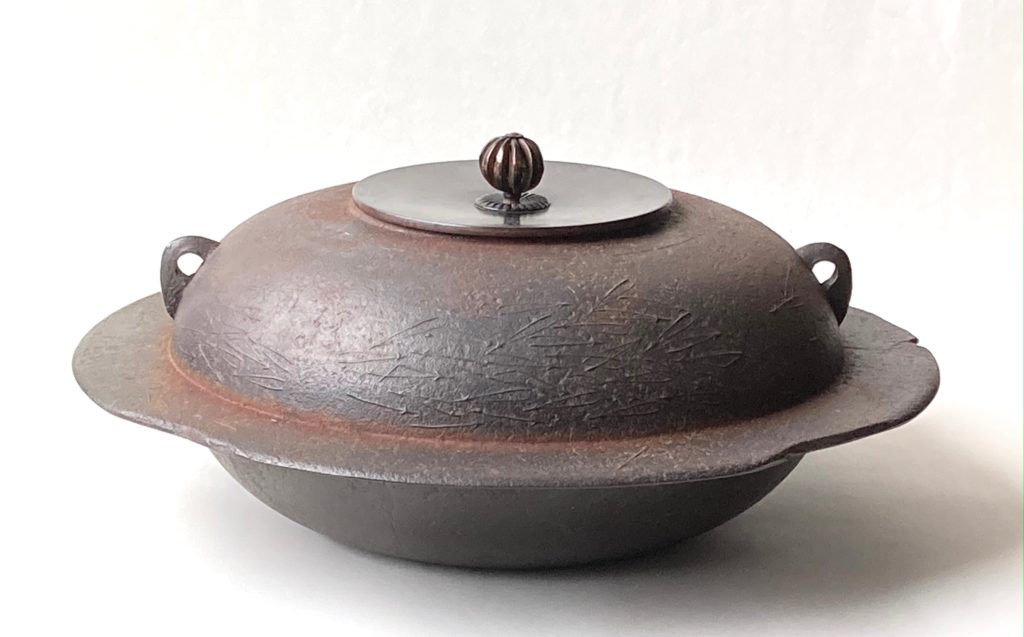
Fugen is master of the principle of Wood, and as such may be associated with the two wooden planks, suki-gi, 透木, gap-wood, that support the kama on the hearth foundation of the ro.
Monju’s double-edged Chi-ken, 智剣, Wisdom-sword, is ablaze with the fire of perfect wisdom and consciousness in all ten directions. The hilt is made of gold, and has a five-prong vajra, go-ko-sho, 五鈷杵, five-cobalt-pestle, at the top.
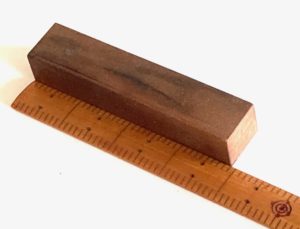
A single suki-gi, 透木, gap-wood: for ro, 炉, hearth, sakura, 桜, cherry, L. 3.9 sun kane-jaku.
The space between the inner edges of the ro-buchi, 炉縁, hearth-frame, is 12 sun kane-jaku. The sukigi is just short of being 1/3rd the distance, however, it is not 4 sun, but 3.9 sun, so that there is a very small discrepancy.
The sukigi are used in both March and April. Urasenke uses the sukigi in April, and Omotesenke uses the sukigi in March, so that there are two wood blocks, with each may be identified with Fugen. The sukigi may also be identified with the Buddhist memorial plaque called i-hai, 位牌, rank-tablet, which bears the name of the departed spirit. Ihai are kept in at a temple or home altar.
After receiving the i-hai, 位牌, rank-tablet, the bereaved family places the small wooden lacquered tablet in their butsudan (a miniature household Buddhist altar where the ancestors who watch over the family are enshrined) where they are usually kept for a certain period of time until it is thought the spirit had merged with the rest of the ancestors. At that point the memorial tablet can either be burned or given to the parishioner temple. The plain wood tablet, will be replaced with the black lacquered tablet when the mourning period expires.
So-tō-ba, 卒塔婆, Die-tower-nurse, plain, narrow, is a flat wooden board with the carved outline of the Go-rin-tō, 五輪塔, Five-ring-tower, that marks a person’s grave. Sotōba with posthumous Buddhist name, kai–myō, 戒名, commandment name, also called Dharma (Buddhist Law) name.
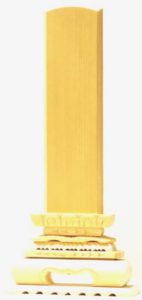
After the 49th day, the sotōba may be burned, but is replaced by the ihai, that has the kaimyō and death date on the front and common name and death age on the back. The ihai is put into the family Butsu-dan, 仏壇, Buddha-altar, and a copy at the family temple. After the 49th day, when the bones are mourned, they may be transferred to a temple or grave.
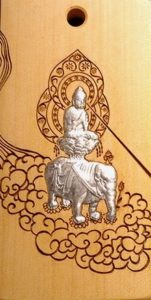
Ki-fuda, 木札, wood-plaque, carved boxwood, with image of Fugen Bosatsu riding on a haku–zō, 白象, white-elephant.
Ki–fuda, 木札, wood-plaque, sold at temples and shrines, used as amulet to ward off evil, and gain protection. The small wooden plaque may be adorned with sacred images, Buddhist deities, animals, etc. Kifuda are provided in various sizes and qualities of wood including boxwood and ebony. They are long, narrow, and thin rectangles with a hole in one end to attach a cord to hang. They are affixed to any object such as a backpack, purse, etc.
The size of a typical kifuda is approximately 12 x 4.5 x .8 cm, which is strikingly close to the size of a joined pair of sukigi for ro; 12 x 4.3 x 1cm. It appears that the sukigi could have had its origins in the sanctified kifuda. It is as though the kifuda was split in half.
In March and April, the wood blocks and the chain to support a kama are used instead of the trivet-like go-toku, 五徳, five-virtues. The gotoku are symbolic of the Go-rin, 五輪, Five-rings: Earth, Water, Fire, Wind, and Void. The Void in Japanese is Kū, 空, which also means sky. [For more on the Gorin see also, Chasen and the Gorintō and Furo Ro: Three Forms ]
Monju Bosatsu preached about Kū, 空, Void, which is the highest of the Go-rin, 五輪, Five-rings, principles. Go-toku, 五徳, Five-virtues, is related to Ri–ttoku, 六徳, six-virtues. Roku-toku, is the Buddhist reading of the Kanji, and refers to Six Virtues: Chi, 知, Wisdom; Jin, 仁, Benevolence; Hijiri, 聖, Virtue; Gi, 義, Righteous; Chū, 忠, Loyalty; Wa, 和, Harmony.
Fugen Bosatsu is known in India as Samantabhadra, which means Universal-worthy, which is transliterated into Japanese, San-man-ta-ba-da-ra, 三曼多跋陀羅, Three-wide-multi-pursue-steep-spread.
One might wonder if there is a connection between the three legs of the gotoku, and groups of three Buddhist deities. Fugen and Monju accompany the historical Buddha in the Sha-ka San-zon, 釈迦三尊, Sakya Three-lords. Other sanzon include, Amida with Seishi and Kannon, Yakushi, Medicine Master, with Nikkō, Sunlight, and Gakkō, Moonlight. When the gotoku is placed in the hearth with the legs upright, two legs are at the front, and one centered in back. The placement in the ro varies. Ordinarily, two legs are parallel with the left side of the ro, so that the far leg is more aligned with the imae of the teishu. For the most formal presentation, the far leg is directly opposite the front side of the hearth.
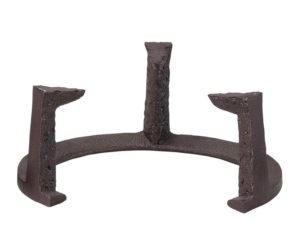
One third of the gotoku ring is absent to allow space for the upright, low-fired ceramic tile, mae-kawarake, 前土器, fore-earth-container, that deflects the heat of the fire up to the kama. The partial ring is buried in the ash bed, with tsume, 爪, talons, revealed. Rust in Japanese is sabi, 錆, and is often conflated with sabi, 寂, the aesthetic of loss and disparity. The Kanji, 寂, is also read jaku, the feeling one has learning of the death of their spiritual guide: the culmination of Wa Kei Sei Jaku.
The three legs of the gotoku may evoke the Shaka Triad: the Buddha accompanied by Fugen on his right, and Monju on his left. The three legs of the gotoku are united by the ring. The gotoku used with the furo has a partial ring, but still unites the three legs, which helps the association of two legs flanking a central leg. This aids in equating the legs with the three deities. It should be understood that Fugen and Monju are ultimately In and Yō manifestations of the Buddha’s practice and wisdom, so that the legs are of equal quality. Fugen and Ganesha are both deities of wisdom.
Fugen may be identified with the teishu, as he is to the Buddha’s right side which is the location of the teishu in the yojōhan. Fugen is depicted holding a lotus flower and bud on a long stem, and it should be remembered that the form of the Tenmoku teabowl is modeled on the lotus.
The three deities of the Sha-ka San-zon, 釈迦三尊, may be represented by the gotoku, with its three tsume. The Buddha is located in the center, the far tsume, and Fugen on the left as the kei-zume, and identified with the teishu, and Monju on the right as is the kyaku-zume, on the side of the kyaku, guest. It is curious that the word ‘kyaku’–zume, 脚爪, leg-claw, sounds like the word ‘kyaku,’客, guest. Monju is identified with the guests in the east.
The ‘talons’ of the san-ko-sho, 三鈷杵, three-cobalt-pestle, are three-sided, which is the same as the legs of the gotoku. Kon-gō–rei, 金剛鈴, Gold-strong-bell, has the ‘talons’ at the opposite end, which may be likened to the gotoku and the kama, but pointing in opposite directions and juxtaposition. Pine trees have a variety of types with varying number of needles. A pine tree with clusters of three needles that may be called san-ko no matsu, 三角の松, three-cobalt’s pine, exemplified by the sankosho.
The three-prong trident and Fugen’s three finger mudra are identified with three concepts: shi-ko, 思考, thought; koto–ba, 言葉, word-leaf; kō–dō, 行動, go-move, behavior. These three refer to the Mi-kkyō, 密教, Secret-faith, Mitsu no Nazo, 三の謎, Three’s Mysteries: Mei-sō, 瞑想, Closed eyes-concept, meditation – is Dō, 道, Way; Shin-gon, 真言, True-word, Mantra – Gaku, 学, Learning; In–sō, 印相, Sign-aspect, Mudra – Jitsu, 実, Practice. ‘Dō Gaku Jitsu’ is a favorite expression of Hōunsai’s
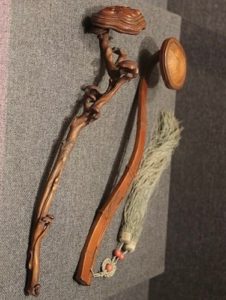
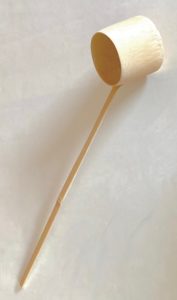
The Chinese believe that Fugen was a primordial deity from which all deities have come. Wisdom and Kindness. Fugen is often depicted holding a lingzhi staff. Lingzhi, Japanese rei-shi, 霊芝, soul-grass, is bracket fungus, Ganoderma lucidum, reishi mushroom. The hi-shaku, 柄杓, may represent the reishi mushroom.
The idealized icon of Fugen is of a 16 year-old youth riding an elephant, who holds a sword in his right hand, and in his left hand holds a blue lotus flower, often with a three-prong vajra on it, and he wears a five-pointed crown depicting five Buddhas. Fugen’s sword may be identified with the kei-saku, 警策, admonish-means, held by the monk presiding over Zazen practice in the Zen-dō, 禅堂, Zen-hall, used to strike the trapezius muscles on the back of the shoulders of the sitter. The Japanese word for the trapezius muscles is sō-bō-kin, 僧帽筋, monk-hat-muscle, which appears to have its name origins in Buddhism.
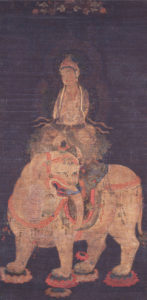
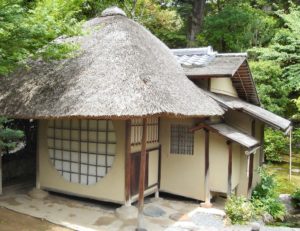
Left: Fugen riding on Haku-zō. Notice each of his four feet supported on a lotus flower. Right: Chashitsu, I-hō-an, 遺芳庵, Linger-fragrance-hut, Kō-dai-ji, 高台寺, High-support-temple, Kyōto, with individual hashira, 柱, posts, not imbedded in the ground, but supported on stones set in the foundation
The yojōhan chashitsu may represent an elephant. This is pure conjecture. The essential structural parts of the Tearoom are the four corner posts, hashira, 柱, The tokobashira is a fifth post, although actually it is not exactly a supporting member as it doesn’t not touch the foundation as do the corner posts, neither does it extend to the roof. Therefore, it may be imagined that the Tearoom has five posts, go-hashira. [See also, April in Japan: Following Elephants]
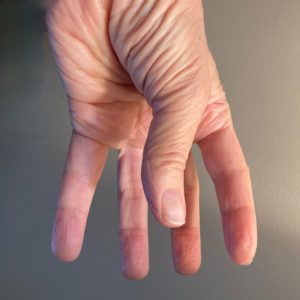
The thumb, in Japanese, is oya yubi, 親指, parent-finger. In English the hand has five fingers, but often the thumb is identified as being separate from the fingers: the thumb and four fingers. Human beings are distinguished from other primates for having opposable thumbs, and therefore more dexterous. The thumb works in tandem with the fingers much of the time.
The human hand has features that may be present in an elephant. The four fingers could be identified with the four legs of the elephant, and the thumb could be identified with the elephant’s trunk. It is curious that the word for the toko-bashira is that is made from the trunk of a tree. An elephant’s trunk is called zō-no-hana, 象の鼻, elephant-’s-nose, without specific reference to its being called a trunk. The Japanese word hana, 鼻 , for nose, is a homonym for hana, 花, flower. The toko-bashira usually has a hook in it about midway facing inward toward the kakemono, 掛け物, hang-thing.
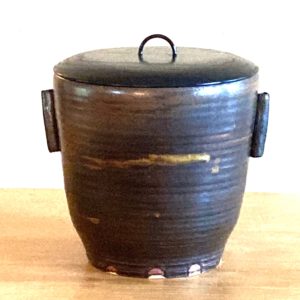
In Japan, Fugen is one of the Jū-san-butsu, 十三仏, Ten-three-buddhas, who presiding over the memorial services, and he reigns on the 28th day after a person’s death. It should be remembered that Rikyū committed suicide on the 28th day of the 2nd lunar month. The 28th day of every month is protected by Fu-dō Myō-ō, 不動明王, No-move Bright-king, who may be represented in the Tearoom also by the tei-shu, 亭主, house-master. Fudō is the shu-yō na, 主要な, master-essence, principal, member of the Go-dai-myō-ō, 五大明王, Five-great-bright-kings. The Kanji, 主, means ‘master of fire’, and Fudō is the very essence of fire.
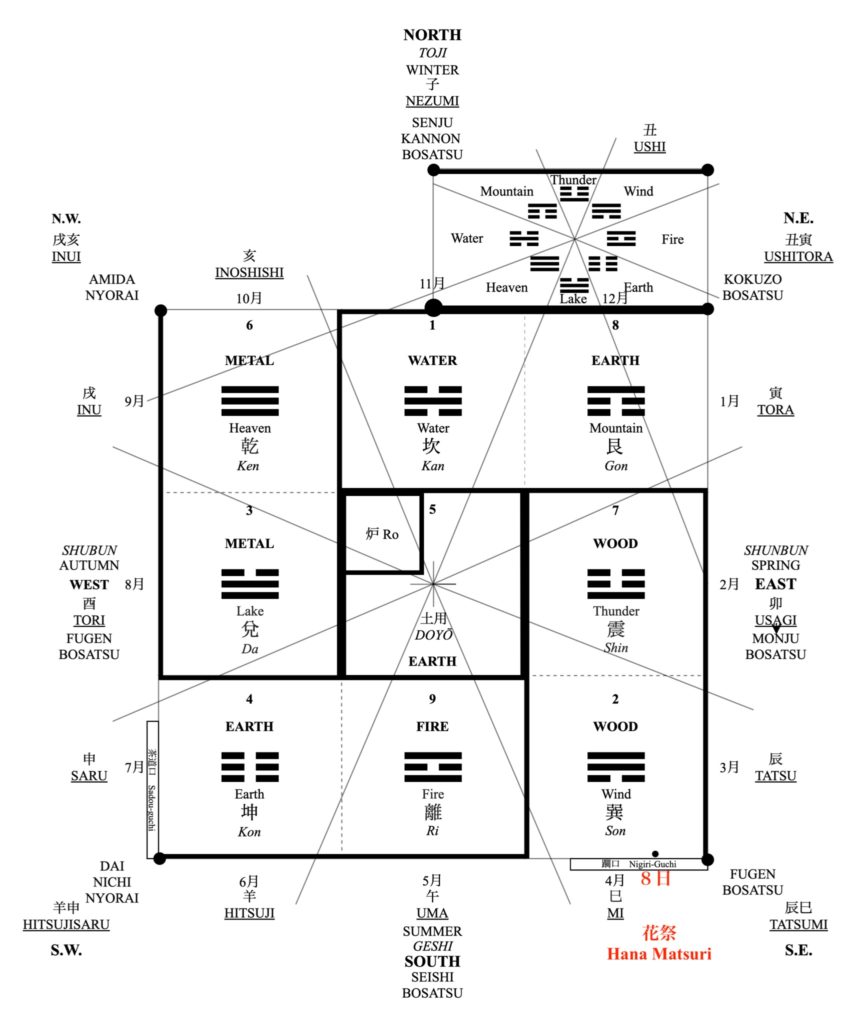
The Buddha’s birthday in Japanese is called Hana Matsuri, 花祭, Flower Festival, which occurs on the 8th day of the 4th lunar month. This corresponds with the ideal location of the nijiri-guchi, 躙口, crawl in-opening, of the yojōhan chashitsu. One enters the Tearoom on the day of Buddha’s birth. Although this often occurs in Japan when the, sakura, 桜, cherry, trees are in bloom, people assume that the hana of Hana Matsuri is the cherry blossom, however, the flower is the lotus, hasu, 蓮, on which one is born in Buddhist paradise.
The 4th lunar month is marked with the Asian zodiac sign of the Mi, 巳, Snake, and guarded by Fugen. This is Rikyū’s concept of entering the Tearoom with the ‘good wind’ of the southeast. This may have been mere coincidence, but perhaps Rikyū intended to make some association between the entrance and exit and a snake.

Tan-zaku, 短冊, short-volume, pasteboard with calligraphy, ‘Ichi go ichi hebi ’, 一期一蛇, one time one snake, with painting of a coiled snake, hebi, 蛇, by Tsu-ji Jō-kan, 辻常閑, Crossing Ever-idle, abbot of Kichi-jō-ji, 吉祥寺, Luck-joy-temple, branch of Dai-toku-ji, 大徳寺, Great-virtue-temple, Kyōto. The body of the snake is adorned with shō chiku bai, 松竹梅, pine bamboo prunus, which are emblems of the New Year. The red string is symbolic of the uniting of the universe, toward the possibility of enlightenment.
Asia has been the birthplace of many sciences, and one all-pervading concept is the function of the nervous system called kundalini. The kundalini is conceived of a coiled snake, which begins below the base of the spine, moves up the backbone and into the brain. It proceeds down the face, chest, and terminates at the pudendum, which is the root of the column of the chakras that ascend again to the brain and above.
The central column is identified as the Sushumna nadi, flanked on the left by Ida nadi, represented as the Moon which carries the red nectar of the Sun, from the base of the body upward. On the right Pingala nadi, represented as the Sun, and carries the white nectar of Moon. These latter two channels are like conduits for the energy that moves somewhat like electrical impulses in the nervous system. The red and white nectars combine at the throat creating the Soma, the Elixir of Life, that is also called kan-ro, 甘露, sweet-dew, ambrosia, Tea. The three nadis may have their own connections with the three-prong gotoku.
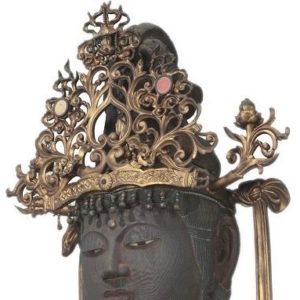
The development of kundalini is likened to a fish swimming up a waterfall, the backbone, and emerging in the brain transforming into a dragon of enlightenment. This is depicted in metaphor in summery hanging scrolls of a carp swimming up a waterfall.
The dragon moves to the forehead, and the location of the third eye, where it is transformed into a snake. This is manifest in the snake crown of pharaohs in Egypt. The source of the snake is manifest in the jewel representing the third eye on the forehead of the figure of Kannon.
In Japan, the kundalini is personified as Gun-da-ri, 軍荼利, War-weed-advantage. He is depicted with a snake wrapped around body, eight arms, two arms across his chest. He is the guardian of the south, and his snake, hebi, may relate to Fugen’s snake, which is also in the east southeast.
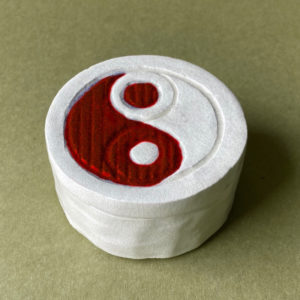
For further study, see also: April in Japan: Following Elephants, Tea in April, Go-Gatsu, Tea in May, Chashaku and Taishakuten, Seikimori Ishi and Ganesha

